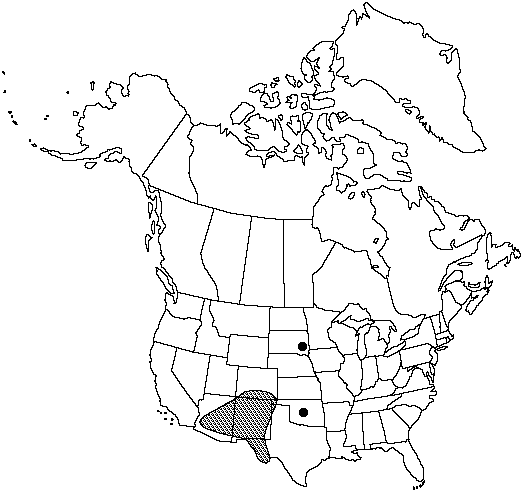Woodsia neomexicana
Contr. Univ. Michigan Herb. 19: 52. 1993.
Stems compact, erect to ascending, with few to many persistent petiole bases of unequal lengths; scales mostly uniformly brown but at least some bicolored with dark central stripe and pale brown margins, narrowly lanceolate. Leaves 4–30 × 1.5–6 cm. Petiole light brown or straw-colored when mature, occasionally darker at very base, not articulate above base, relatively brittle and easily shattered. Blade linear to lanceolate, usually pinnate-pinnatifid proximally, glabrescent to sparsely glandular, never viscid; glandular hairs with thin stalks and slightly expanded tips; rachis with scattered glandular hairs and rare, hairlike scales. Pinnae ovate-deltate to elliptic, longer than wide, abruptly tapered to a rounded or broadly acute apex; largest pinnae with 3–7 pairs of closely spaced pinnules; abaxial and adaxial surfaces glabrescent to sparsely glandular, lacking nonglandular hairs or scales. Pinnules dentate, often shallowly lobed; margins nonlustrous, thin, with occasional glands, lacking cilia, with 1–2-celled translucent projections on teeth. Vein tips occasionally enlarged to form whitish hydathodes visible adaxially. Indusia of narrow, filamentous segments, these uniseriate for most of length, composed of ± isodiametric cells, usually surpassing mature sporangia. Spores averaging 44–52 µm. 2n = 152.
Phenology: Sporulating summer–fall.
Habitat: Cliffs and rocky slopes, usually on sandstone or igneous substrates
Elevation: 300–3500 m
Distribution

Ariz., Colo., N.Mex., Okla., S.Dak., Tex.
Discussion
Woodsia neomexicana traditionally has been identified as W. mexicana. Both taxa are tetraploid and may share one parent (M. D. Windham 1993); W. neomexicana is separated from typical W. mexicana by its completely filamentous indusial segments, reduced glandularity, and more northerly distribution. Isozyme data suggest that W. neomexicana is an allotetraploid hybrid between W. phillipsii and the diploid progenitor of W. oregana subsp. cathcartiana (M. D. Windham 1993). As with all allopolyploids, W. neomexicana can vary in the direction of either parent, and some plants (especially those resembling W. phillipsii) can be difficult to identify. All characters except those controlled directly by ploidy level show this tendency, and spore size remains the most dependable character for distinguishing W. phillipsii and W. neomexicana. This species hybridizes with W. oregana subsp. cathcartiana and W. phillipsii to produce sterile tetraploids and triploids, respectively.
Selected References
None.